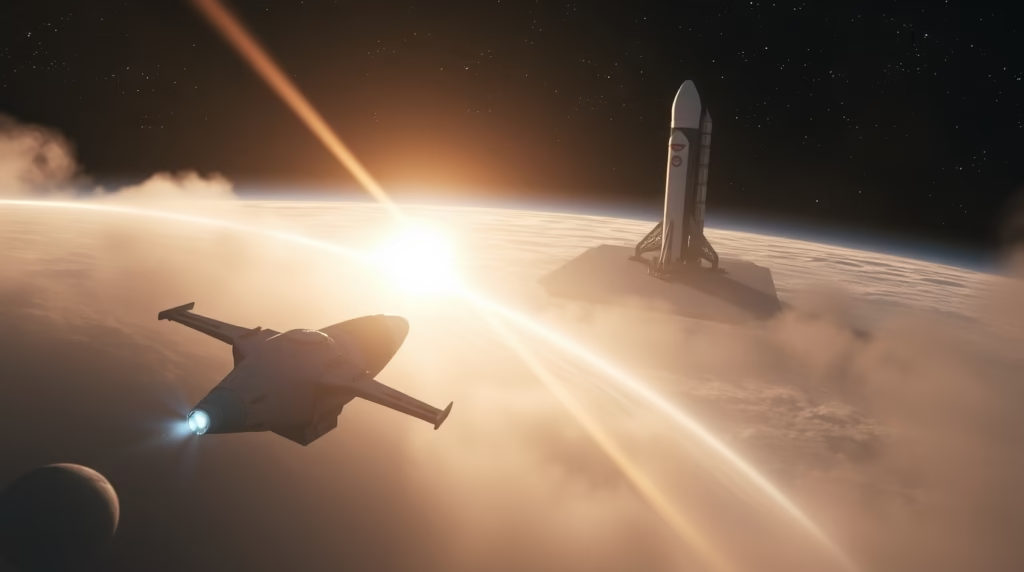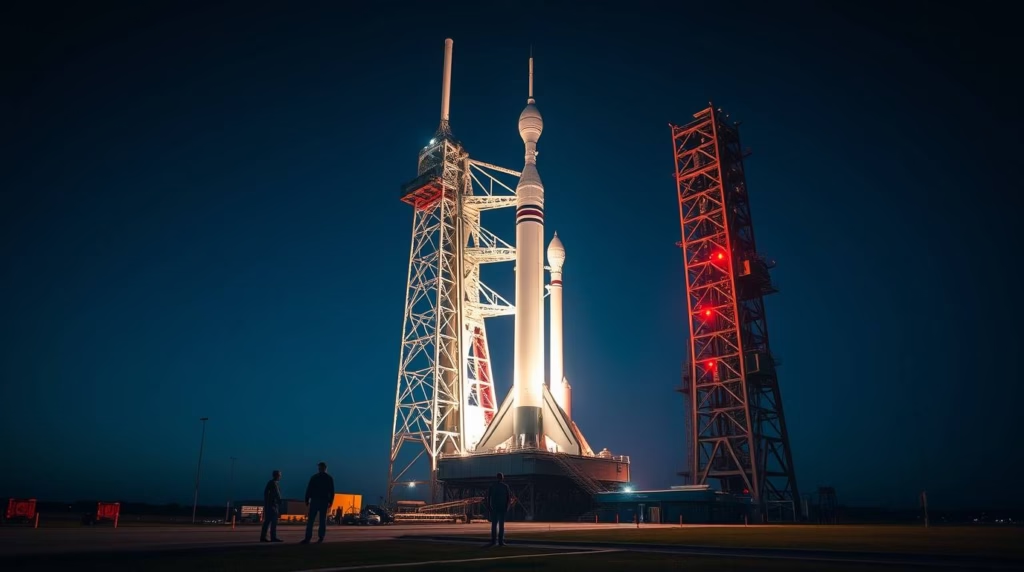NASA Artemis II Mission: Launch Date, Mission Overview, and Crew Members
NASA’s Artemis II mission, scheduled for April 2026, marks the beginning of a new era in human space exploration. It will be the first crewed flight under the Artemis program, taking four astronauts aboard the powerful Space Launch System (SLS) rocket and the Orion spacecraft on a journey around the Moon. This mission serves as a crucial test to validate critical systems, technologies, and operations needed for future lunar and Martian expeditions. More than a half-century after the last Apollo Moon landing, Artemis II carries with it the dream of taking humanity back to the lunar surface and beyond.
Artemis II follows the historic success of Artemis I, an uncrewed mission launched in 2022. The Artemis I mission tested the SLS rocket and Orion spacecraft, traveling around the Moon and returning safely to Earth. Building on these achievements, Artemis II will for the first time send astronauts on a deep-space mission that prepares the way for longer-term human presence on the Moon.
With the Artemis program, NASA is not just planning another Moon landing. It aims to establish a sustainable presence in deep space, test life-supporting systems for human survival, and eventually create the technological and logistical foundation for the ultimate goal: sending astronauts to Mars.
Artemis II Launch Date
The highly anticipated Artemis II mission is scheduled for April 2026. The launch will take place from Kennedy Space Center in Florida, where NASA’s historic Apollo missions once lifted off more than five decades ago.
The mission is expected to last approximately 10 days, during which the crew will travel farther into space than any astronauts have ventured before. Unlike Artemis I, which was uncrewed, Artemis II will have four crew members operating Orion in deep space. This journey signifies a pivotal step forward and rekindles worldwide excitement for lunar exploration.
Artemis II Mission Objectives
At its core, Artemis II is a test flight, but one of extraordinary importance. It is designed to answer key questions about astronaut survival and spacecraft functionality in deep space. While the mission will not include a Moon landing, it is a stepping stone toward future Artemis missions where astronauts will walk on the lunar surface again.
Key objectives include:
-
Testing critical systems of Orion spacecraft with humans aboard. While Artemis I showed Orion could safely travel to the Moon and back, Artemis II will confirm its safety with a crew onboard.
-
Assessing life support systems such as oxygen flow, carbon dioxide removal, and temperature regulation. These are essential to ensure astronauts can safely live and work for extended durations in lunar orbit and beyond.
-
Evaluating deep space communications by connecting Orion to NASA’s global Deep Space Network and monitoring its effectiveness in real-time operations.
-
Practicing manual maneuvers. The astronauts will demonstrate Orion’s ability to perform maneuvers near the upper stage of the SLS rocket, a critical skill for future docking procedures during space missions.
Flight Trajectory of Artemis II
Artemis II will showcase a precisely planned flight path known as a free-return trajectory. This trajectory ensures that once the spacecraft slingshots around the Moon, gravity from Earth will automatically bring it home—an important failsafe in case of any technical issues.
-
Initial Earth Orbit: After liftoff atop the SLS rocket, Orion will orbit Earth twice.
-
The first orbit will be in low-Earth orbit to test Orion’s systems.
-
The second orbit, in high-Earth orbit, will test its engines more extensively and give Orion the velocity needed to leave Earth’s gravity.
-
-
Lunar Flyby: Orion will travel about 4,700 miles beyond the far side of the Moon, farther than any human spacecraft has ventured before.
-
Return Trajectory: Using Earth’s gravity, Orion will follow a looping path back home, landing safely in the Pacific Ocean.
Crew Members Aboard Artemis II
NASA has announced an international and diverse crew for Artemis II, embodying global cooperation in space exploration:
-
Reid Wiseman (Commander): A decorated NASA astronaut and U.S. Navy aviator, Wiseman previously lived and worked aboard the International Space Station (ISS). He brings extensive leadership and spaceflight experience.
-
Victor Glover (Pilot): A U.S. Navy test pilot and astronaut, Glover became the first African-American astronaut to live long-term aboard the ISS during the Crew-1 mission in 2020. His inclusion as the pilot represents a major milestone in representation and achievement.
-
Christina H. Koch (Mission Specialist): Known for her record-breaking 328-day mission aboard the ISS, Koch holds the record for the longest spaceflight by a woman. She will be extremely valuable in testing Orion’s life-support systems.
-
Jeremy Hansen (Mission Specialist): Representing the Canadian Space Agency (CSA), Hansen becomes the first Canadian astronaut chosen for a journey around the Moon. His participation underlines NASA’s collaboration with international partners.
The diverse crew is seen as a reflection of NASA’s commitment not only to advancing space exploration but also to promoting inclusivity and international partnership.
Technical Evaluations Planned in Artemis II
During the 10-day journey, the astronauts will conduct several in-flight tests and evaluations to validate spacecraft functionality:
-
Life Support Systems: Real-time tests of oxygen delivery systems, removal of carbon dioxide, humidity control, and cabin pressure regulation.
-
Communications: Extensive use of NASA’s Deep Space Network to ensure Orion remains connected during its farthest journey from Earth.
-
Manual Maneuvers: Astronauts will practice docking maneuvers by piloting Orion around the SLS second stage. This simulates operations future Artemis astronauts would use during lunar landings and construction of the Lunar Gateway station.
-
Radiation and Health Monitoring: Astronauts will undergo medical monitoring to study the effects of space radiation, which will guide long-term deep-space exploration strategies.

Why Artemis II Matters
The significance of Artemis II extends far beyond a single mission. Here’s why this milestone is so critical:
-
Return to Human Lunar Exploration: It represents humanity’s commitment to returning to the Moon after 50 years.
-
Gateway to Mars: Artemis II technologies will provide essential data for missions to Mars, which require longer durations in space.
-
Strengthening Global Partnerships: With Canadians and Americans working together, the mission strengthens multinational space partnerships.
-
Inspiration for the Next Generation: Just as Apollo inspired a new age of engineers, scientists, and explorers, Artemis aims to ignite inspiration worldwide.
NASA’s vision is clear: the Moon is not the final destination but the training ground for missions deeper into the solar system.
Artemis Program Roadmap
Artemis II is one part of a broader strategy. Here’s what comes next:
-
Artemis III (2027): Planned first crewed lunar landing since the Apollo era, targeting the lunar South Pole.
-
Artemis IV and Beyond: Construction of the Lunar Gateway, a space station orbiting the Moon, and expansion of long-term lunar exploration.
-
Beyond the Moon: Technology and infrastructure developed during Artemis missions will form the foundation for sending humans to Mars in the 2030s.
NASA Administrator Bill Nelson has described Artemis as “the beginning of a new era of human spaceflight.” With Artemis, NASA is building not just rockets and spacecraft, but the very future of human exploration.
Final Thoughts
The upcoming NASA Artemis II mission in April 2026 is not just a return to the Moon but a leap toward humankind’s long-term future in space. This 10-day mission will verify critical life-support, navigation, and communication systems, taking astronauts farther than any human has ever gone. With a diverse international crew, the mission symbolizes global unity in exploration and innovation.
By paving the way for Artemis III and subsequent missions, Artemis II brings humanity closer to building a permanent presence on the Moon and preparing for the groundbreaking challenge of setting foot on Mars.
for more news Click HERE

